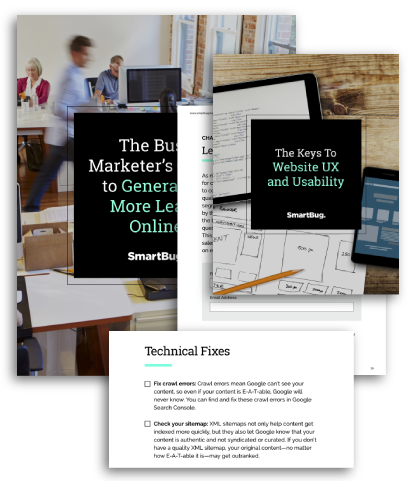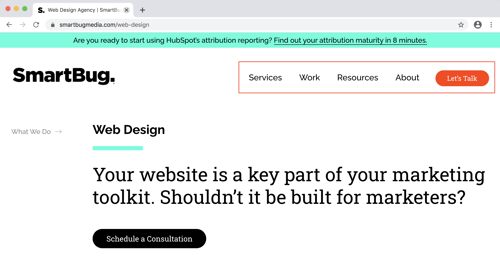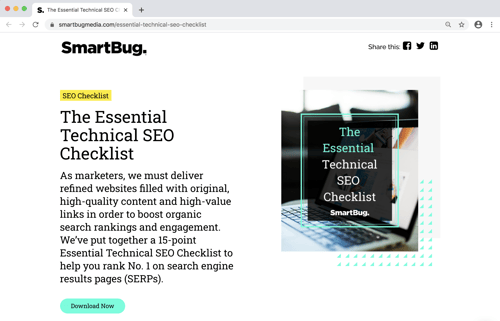
The Complete Guide to Landing Pages
Years ago, HubSpot conducted research on landing pages that it continues to stand by: Websites that use more landing pages generate significantly more leads.
However, some marketers don’t realize the potential landing pages hold. These simple webpages are crucial to gathering data about leads and customers. Landing pages also promote your brand, maximize your content, and help drive the Buyer’s Journey.
Ignoring or putting little effort into landing pages wastes a golden opportunity to realize your inbound marketing goals. This guide details everything you need to know about landing pages and how they can complement and jumpstart your entire marketing strategy.
Get the Landing Page Improvement Bundle
Download the landing page improvement bundle to improve your visitors’ experience, improve your conversion rate, and increase your organic search traffic. This bundle includes “The Keys to Website UX and Usability”, “The Busy Marketer’s Guide to Generating More Leads Online”, and “The Essential Technical SEO Checklist”

Chapters
What Is a Landing Page?
The Conversion Process
Landing the Perfect Landing Pages
Using the Data
Conclusion
What Is a Landing Page?

The term “landing page” often is thrown around without people truly understanding what it is. Consumers usually have no idea they’ve reached a landing page—they just know they clicked on something and it brought them to another webpage. Moreover, outside of their website experts and marketers, many organizations don’t grasp the role landing pages play in bringing in leads and customers.
Therefore, to know how to take full advantage of landing pages, you must know what they are, what they accomplish, and what benefits they offer.
A Landing Page, Defined
Broadly defined, a landing page is a webpage that a user arrives at by clicking from another source, whether it’s another webpage, a social media post, a paid digital ad, and so on. A fundamental distinction between a landing page and, say, any other page on a website is that the landing page is designed to be clicked to—it’s generally not something users seek directly.
For inbound marketing, a landing page is something more specific—and much more impactful. Inbound landing pages aim to convert visitors into leads, marketing qualified leads (MQL) into sales qualified leads (SQLs), or existing customers into brand advocates.
To know how to take full advantage of landing pages, you must know what they are, what they accomplish, and what benefits they offer.
Landing pages may vary in their construction and goals, but they basically consist of three things:
- Text to describe the offer, resource, or event being provided to the user
- A form the user fills out to access the resource
- A graphical button to complete the “transaction”
A landing page should also be attached to a thank you page—the place a user is directed after completing and sending the form.
Trust Is Key
Inbound marketing values relationships. People have pain points and challenges; organizations offer empathy, guidance, and solutions—even if the end result isn’t a sale. Trust is necessary for these relationships to grow, and nowhere is this trust more evident than the experience of a landing page and its follow up.
Website visitors protect their personal information, and rightly so: Spam emails, constant robocalls, and identity theft are real consequences of giving such info to the wrong people. However, inbound marketing operates on prospects’ info to nurture their journeys toward a sale, as well as to tailor marketing tactics to individual pain points and needs.
A landing page relies on trust to deliver something of value to both the lead and the marketer. You are providing helpful resources—such as solutions to pain points or access to experts in the form of an e-book download, an industry report, access to a webinar, printable worksheets, and so on—in exchange for users’ basic information, which can include name, company title, email address, and phone number.
Gated content still scares away some people, so the resources you offer must be attractive enough so visitors will accept the “risk” by filling out the form. Furthermore, your content must be high quality, because a user will feel cheated if it’s not—and then look elsewhere for the trust you failed to deliver.
A note on gating: Pillar pages, with their long-form content out in the open, can still have a form to access the content in a downloadable package and actually create conversions. Knowing this, the choice between whether to create a pillar page or a landing page comes back to one facet of the landing page definition: Do you want to have more control over who is coming to your page by creating campaigns that drive clicks to it? In this case, a landing page is your best choice. Do you want the page to drive its own organic traffic? Then you should build a pillar page.
More Than Just a Webpage
Some marketers view landing pages as just a task that takes up time and resources so that website visitors have a place to convert. Inbound marketing blows up this view by making landing pages not only a destination but also an opportunity.
Demand-generation marketing goals emphasize attracting and impressing leads, cementing conversions, and nurturing eventual sales. When landing pages are thoughtfully constructed, they can achieve these goals.
A dynamic landing page builds excitement for your thought leadership and, ultimately, your product.
Whether they are in the awareness, consideration or decision stage, prospects on landing pages want to learn more—otherwise, they wouldn’t have clicked through. Your job as a marketer is to give them that information, then inspire them to want to further expand their knowledge by downloading that e-book or registering for that webinar. A dynamic landing page builds excitement for your thought leadership and, ultimately, your product. A dull page can make a lead regret ever clicking.
Approaching landing pages as an opportunity to delight the visitor increases the odds of capturing the visitor’s attention. In this way, you’re marketing without leads quite realizing they’re being marketed to—and giving them the control to proceed with the relationship (i.e., by filling out the lead capture form).
Types of Landing Pages
Although inbound landing pages are focused with their goals (e.g., conversions and lead nurturing), many kinds of pages are available to complement your marketing strategy. Here are a few of your options:
Lead generation capture pages
Also known as squeeze pages, these are the most common inbound landing pages and are generally what we’ve been talking about throughout this section. Basically, visitors arrive on the page and fill out a form, thus officially turning them into leads while capturing their info—most importantly, their email addresses.
Bonus: 6 Steps to Create a Landing Page That Drives More Leads
Clickthrough pages
As leads get closer to making a decision, they may require less thought leadership and more hard facts about your product. Clickthrough pages provide an intermediary step between a link or outside channel and decision-stage offerings such as pricing information or a free trial. You aren’t necessarily asking for more information, but you are nurturing the lead as well as capturing data on whether the lead converts.
Subscription pages
When you invite someone to subscribe to your blog, they need to fill out a form. A subscription landing page provides that form and gives the user options on how they’ll be notified when a new article is available. This feels less like a transaction for the lead and more an opt-in step, which may mean decreased hesitation to fill out the form.
Unsubscribe pages
A user who opts into your blog or email newsletter may someday want to opt out. An unsubscribe page allows them to do so with no fuss—but not without you lightly encouraging them to stay. You can also include a check-the-box or pulldown menu form field here to learn why users want to unsubscribe.
Start pages
These landing pages are perfect for people clicking into your website—say, from a paid ad—simply to learn more information rather than to download a specific resource. They arrive on a page welcoming them to your site and brand, and click on a button that says, “Get Started” or “Start Here” (or something equally as inviting) to proceed into your website. You’re providing them with a warm greeting and message tailored to this audience and campaign, and in return you’re generating conversion data when they click or don’t click.
Thank you pages
As already stated, thank you pages complete the process started on a landing page. We’ll cover their best practices in another section of this guide, but these pages are vital to the conversion process and can further help move leads toward a sale.
Resources
The Conversion Process

Inbound marketing recognizes that a person’s path to sale isn’t instantaneous—it’s a series of small conversions that moves a lead closer to the deal. Understanding this process will help you approach landing pages with the focus squarely on your audience.
The Buyer’s Journey
Understanding the Buyer’s Journey helps put the importance of landing pages in perspective. In the inbound marketing methodology, the Buyer’s Journey is the path someone takes from website visitor to lead to customer. It’s generally broken down into three stages:
Awareness
A person has a problem and searches online for information to solve that problem. Ideally, that search and all your marketing efforts attract them to your website.
Consideration
The lead understands some solutions to the problem and is evaluating which one will work best.
Decision
The lead has decided on a solution and is ready to choose a company to execute that solution. Hopefully, that solution is yours.
There’s an unofficial fourth stage: delight—how you engage existing customers and turn them into repeat customers and brand advocates.
Content such as e-books, infographics, videos, kits, and webinars help move leads through the Buyer’s Journey. Landing pages, which can be tailored to each stage, bring some of this content to leads while capturing their data—which then is used for more lead nurturing and to inform marketing strategy.
Clicking Through
No matter how well you build your landing pages, they won’t be effective if nobody clicks to them. Some of the ways people arrive at your landing pages include:
- Internal links
- Calls to action
- Internal navigation
- Emails
- Search engine results
- External sites
- Social media posts
- Paid ads
Although the channels visitors arrive through may vary, the ultimate goal of a landing page remains the same: getting them to convert on your offer and provide their information, which then ends up in your database. That said, landing pages can be tweaked to better appeal to the channel from which they came. For example, a visitor who clicked from a paid ad might benefit from a landing page with more explanation of your product than someone who was already on your website and clicked on a call to action (CTA) in your blog.
Bonus: 10 ways to optimize your PPC pages that aren’t converting
The Moment of Truth
An inbound landing page presents a sort of do-or-die moment for your relationship with visitors and leads. If they convert, you can begin—or continue—to direct their path toward a sale. With data from these leads in hand, you can send nurturing emails, suggest other helpful resources, send special offers, and understand who is visiting your website and what they are looking for.
When leads don’t convert, there’s a possibility they never will. Perhaps they aren’t interested in the offer or your product—which of course happens even with the most successfully marketed brand. Or perhaps they simply aren’t ready to commit their information at this time. Landing pages should encourage people to convert, not deter them. Visitors will decide on their own whether to fill out the form or not; landing pages help state your case.
Thank You Pages
After someone converts on a landing page, they should be automatically sent to a thank you page that you’ve built. This show of gratitude is also your first lead nurturing step with the new or further invested lead. Effective thank you pages:
- Allow the user to complete the download of an e-book or other printed resource (the page can be bookmarked, too, if the person wants to re-download the PDF later)
- Confirm registration with events such as webinars
- Restore the website navigation that you might have taken off the landing page (which is a best practice that will be explained in the next section)
- Offer other resources leads can check out, either immediately or at their leisure
- Possibly include another form to request more information
We’ll touch upon some thank you page best practices in the next section, but for now, follow this guideline: Always build a thank you page for any squeeze landing page someone might convert on.
Landing the Perfect Landing Pages

Ideally, you want landing page visitors to be compelled as soon as they arrive on the page, then continue to like what they see and convert on the offer. If that feels like a bit of pressure, well, it is—sort of. With practice and patience, you can efficiently create landing pages that perform well.
Best Practices
There is no absolute right way to build a landing page, but there are many best practices marketers have refined over the years.
Simple Forms to Smart Forms
Perhaps nothing is more important on an inbound landing page than the lead capture form you want prospects to fill. Forms collect the data you need to drive your marketing strategy—so if someone is refusing to use the form, you’ll not only lose the conversion, but also miss out on valuable marketing intelligence.
Essentially, the substance and scope of the form shouldn’t be what’s preventing people from filling it out. The key is finding a reasonable balance of how much info to ask for and how much you need. A form with 12 questions for an awareness stage offer will likely be ignored—the ask is too big for the return. Alternately, a form that doesn’t ask for an email address won’t provide a way to effectively nurture a converted lead via email.
For basic offers, keep the form simple: name, email address, company, and maybe a quick fourth question. Don’t ask for long answers, and don’t convolute drop-down fields with too many choices. This landing page transaction is an introduction, not a long negotiation.
This strategy doesn’t mean you can’t get more complex with your questioning on subsequent landing pages that a lead visits. Smart forms identify if a lead has previously filled out a form on your website, then presents a new series of fields to be completed. With smart forms, leads don’t feel like they are answering the same questions over and over because they aren’t, and you gather new data to drive your overall marketing strategy.
No Navigation
You want to give anyone arriving on an inbound landing page two choices: convert or don’t convert. Of course, you hope they will fill out the form and convert, but you don’t want to unnecessarily distract them from that with other links—specifically, website navigation that could take them elsewhere on your site.
The best way to keep visitors focused on landing pages is to remove the navigation from the layout. This way, they either convert or click on the back button (or close the page) to move on. The strategy seems a little drastic, but it’s the best way to collect focused marketing data and provide some extra, gentle impetus to fill out the form—because the user literally has no other way forward.

Navigation on a regular website page

On a landing page, beyond the clickable logo, the regular navigation is replaced with social sharing buttons.
Impactful Art and Graphics
Visually, there’s no reason for a landing page to be bland—a well-designed page will increase the chance of a conversion. Follow these guidelines:
Hero Image and Other Art
Pick a hero image that reflects the offer without being too stocky. A candid snapshot of a gardener tending to his beautiful green lawn or a blooming dandelion is relevant for a downloadable guide about getting rid of weeds; a staged picture of an over-smiling gardener looking into the camera with a pair of shears may come across as fake.
If possible, include photos of speakers for events landing pages in place of hero image. This puts a human face on the event and lets the potential attendee know that there will be real thought leadership and expertise provided live.
Beyond a hero image, the sky’s the limit with other graphical elements. You can add short videos, more photos, or illustrations. With e-books, a picture of the cover is a common addition to the landing page, showing readers exactly what they’ll receive for filling out the form.
If you choose not to use a hero image, that’s OK, too. Just make sure the landing page has other visual elements and isn’t only text and form.
Fonts, Colors, and Buttons
Landing pages are no different than any other page on your website, in that text fonts and sizes should be appropriate, utilitarian, and consistent. Headlines shouldn’t be too big, and copy shouldn’t be so small that it requires squinting to read. Also, don’t introduce new typefaces in an attempt to shake things up—rely on the same styles you use throughout your brand.
Colors should follow a similar strategy, using the same schemes found in your brand style guide, and avoiding any combinations that are overly funky. A well-designed landing page won’t need additional flash.
Most inbound landing pages include some sort of “download” button to submit the form and complete the process. This button should be prominent so it’s easily found, but not so big that it detracts from the rest of the design. Furthermore, keep the text in the button as brief as possible—something like “Download Now” or “Join Us for the Webinar” is clear and prompts the visitor.
Social Sharing
Add social media sharing buttons to your landing page, thus allowing visitors to share the offer on their accounts and with their followers. Prospects may not share right away, but if they enjoy the resource after using it, or find out a colleague is looking for solutions around the pain points you’re discussing in the upcoming webinar you’re promoting, they could come back to the landing page and share later.
Above the Fold
Inbound landing pages work best when they are streamlined. If a visitor needs to scroll to read the entire page or finish (or even find) the form, the probability of conversion decreases.* Keep your pages above the fold so that users see everything they need right away and can easily convert if they like what they are seeing.
*The exception is when you’re providing value, like sneak peeks that offer transparency and trust, or when you’re offering the full breadth of content ungated in addition to a download behind a form (like in the case of a pillar page with an e-book download). In these value-added cases, the need to scroll doesn’t affect the conversion rates. So the lesson is: Keep it short, but provide value.
Simple, Descriptive Text
A landing page isn’t the place to become verbose or vague. Your web copy should give the reader a reason to fill out the lead capture form and, ultimately, earn your trust. Keep these best practices in mind when writing the text:
Clear Headline
The main headline on the landing page should be the first thing that jumps out to the reader. In just a few words (probably no more than 10, and even that’s pushing it), you’ll need to convince the prospect that the offer is something worth downloading or, at least, reading more about on the rest of the page.
Avoid being cute or theoretical with your landing page headlines: Get to the point on what you’re offering or how you can help the visitor. If the page is promoting a webinar, say, “Join us on our webinar featuring John Doe, expert.”
Value Prop
Set up the problem that the prospect might have by talking about their pain points, then include a value proposition on how your guide/infographic/interactive tool/webinar can solve that problem. Even if there isn’t necessarily a pain point connected with your offer, describe what the landing page visitor will get in return for filling out your form.
Highlights and Features
After the value prop, delve into some of the features of the guide or topics that will be discussed on the webinar. Bullets work well for this task; some advanced landing pages use additional photos and graphics to highlight these points. Don’t include too many features—you want to just tease what the lead can expect, not give everything away.
Keywords
Any keyword research you’ve applied to your website and blog articles can also be used for landing pages. In fact, you should be intelligently using keywords so that if someone asks a question of a search engine that your gated content answers, the odds of the landing page being returned in the results will increase. At a minimum, including a good keyword in the page title and the headline will provide a nice search engine optimization (SEO) boost.
Proofread and edit
Because a landing page is different from most of the other content on your website—such as the homepage, blog articles, and e-books—you may not be quite as meticulous with editing the copy and proofreading the finished page.
Misspellings and grammar mistakes do happen, and some prospects might not be bothered by them ... but some might question your professionalism and thought leadership. Don’t lose a conversion because you spelled something wrong in the main headline; if you don’t have an editor, at the very least give everything a good read before the landing page goes live.
Enthralling Thank You Pages
A thank you page allows leads to access the gated resource. The page also jumpstarts the next marketing touchpoint with CTAs to other resources, the return of the website navigation, and even some cross-promotion of your products. Remember these tips when building thank you pages:
- Be sincere and ask them to share: Invite the lead to connect and comment on social media, and ask them to share their favorite tip they learned from the content.
- Include a confirmation message: If the lead will receive the download in an email—or will receive an email with their unique join URL for logging into a webinar—be sure to add these instructions (e.g., “Check your email to get the guide!”) in the copy.
- Use smart CTAs: Tailor calls to action to reflect what the lead just downloaded/registered for, and add smart CTAs so that a previously downloaded offer isn’t promoted again.
- Make sure the download button works: This sounds like a given, but double-check that when users click the download button, they receive the offer they were seeking and filled out a form to get.
Be Careful ...
Landing page builder beware: Your best intentions can be detrimental if something on the page turns the lead off. Here are some things to look out for as you strive to create high-performing landing pages:
Misalignment of Value
When you ask for the moon in terms of information on a form, you better deliver something just as lunar. Leads might scoff at long forms to get a short infographic in return—or, they might feel cheated if they fill out a form and don’t like what they subsequently download.
Aligning value is crucial to gaining and maintaining a lead’s trust. Furthermore, if your content isn't unique or bespoke enough to be a fair trade for a name and email address, ungate it.
Overloading the Page
The acronym TL;DR stands for “too long; didn’t read.” Landing pages can suffer from a similar acronym we just made up: TL;DD, which is short for “too long, didn’t download.”
You may be excited about the offer you’ve created, but if you get too wordy, you might scare off the reader. Overexplaining is just as dangerous as providing no context at all—if you give away too much information, there might not be a reason for the visitor to download the offer.
Therefore, stay concise and get to the point: How your offer can help solve the prospect’s pain points. If you find yourself with a 1,000-word landing page, you’ve written too much.
Busy Design
Similarly, if a landing page visually overwhelms visitors, they might skip trying to sort everything out to fill in the form—if they find the form and submit button at all. As with other pages on your website, landing page design should appeal, guide, and educate visitors without barraging their senses. Choose photos and graphics that complement your brand while not distracting from the text and form.
Not Addressing the Buyer’s Journey
Consider this scenario: A visitor to a lawncare company’s website clicks on a CTA to possibly download a basic e-book about various weeds that might sprout up in the summer. Upon arriving on the landing page, the copy asks if the lead is ready to hire the company, and the form is asking some personal questions, such as how much the person spends on lawncare each month.
Likely, leads will be turned off by this approach—they just wanted some info on crabgrass and clover, yet received a hard sell. The landing page didn’t understand the Buyer’s Journey, pairing an awareness stage content offer with decision stage messaging, thus resulting in a confused and/or annoyed lead. Aligning your landing page offering with the appropriate inbound messaging ensures users are seeing what they expected and increases the likelihood of a conversion.
Promote the Offer
Landing pages won’t convert if nobody lands on them in the first place. Visitors may arrive from a variety of sources and channels, and you can boost the odds in the following ways:
Internal Navigation
If you’re fortunate, a visitor may organically or directly arrive at your website, poke around for a little bit, and navigate to a landing page and show interest in the offer. Help this adventure along by following navigation best practices and by not burying resources too deep in the website. A dedicated and prominent “Resource Center” page can showcase you premium offers and allow easy access to their corresponding landing pages.
Calls to Action (CTAs)
CTAs, whether they are big and graphical or just a sentence at the end of a blog article, offer perhaps the best way to bring leads to your landing pages—after all, the leads are already on your site and reading your content. These best practices can help you design CTAs that catch people’s attention and inspire them to click.
Internal Links from Blog Articles
Plain, non-CTA internal links are important for SEO, but they also offer a subtle way to get people to landing pages. This strategy is easy as well; just be sure that the linked text is related to the corresponding landing page—in other words, don’t bait-and-switch the reader into clicking to something irrelevant.
Paid Ads
We could write an entire guide on paid search and paid social landing page tactics, so just remember this: If you’re spending money to create and bid on paid ads, be sure the landing page doesn’t disappoint leads once they click.
Social Media Posts
Promoting guides and webinars on social media helps reach leads who might not be regularly visiting your website or reading your emails. While you can post and use hashtags that your buyer persona follows, try and think of even more persuasive ways to get your buyer personas to click: ask questions, communicate with and tag individuals, or find existing questions and answer them while providing a link to your content.
The Landing Page Checklist
The following checklist walks through all the steps you should take when building a landing page. Both HubSpot and Marketo make the process relatively easy; your creativity, research, and strategy make the process a success.
- Impactful headline
- Smart art
- Testimonials
- Optimize for mobile
- Lead capture
- Social sharing
- Behind-the-scenes SEO
- Test it
- Write an impactful headline: Be direct, don’t get too cute, and sell the page and offer.
- Write page copy: Tell readers what your offer is and how it will help with their pain points.
- Choose smart art: Use photos and graphics that support your message; use fonts and colors that are easy to digest and match your brand.
- Create the lead capture form: Consider which and how many questions are appropriate and if they align to the value of the offer.
- Add testimonials: If applicable, add customer testimonials praising the offer and/or your product.
- Add social sharing buttons: Give visitors a chance to share the offer with their followers.
- Add a meta description and alt text: These key SEO steps also apply to landing pages.
- Optimize for mobile: Be sure your landing page displays properly on any of the devices that your buyer persona regularly uses.
- Construct the thank you page: Apply some of the items on this checklist to the thank you page (which, after all, is technically also a landing page).
- Make sure it works: Test your landing page to ensure that it displays how you want it to, that the form can be successfully submitted, that data is being captured, and that it sends visitors to the thank you page.
Resources
How to Use Audience Awareness to Create Higher Converting Post-Click Landing Pages
Read MoreUsing the Data

The heart of inbound marketing is data—every action and interaction produces it, and every strategy and campaign should be based, at least partially, on it. The metrics leading into and flowing from landing pages have implications long after a lead fills out a form and downloads an e-book.
Conversion Rates
By their nature, landing pages don’t return crazy conversion numbers. Generally, a 5 percent conversion rate on, say, an e-book, is considered above average, and 15 percent is considered really good.
This sounds discouraging; however, conversion rates are always relative, and a thousand people seeing a CTA and 150 clicking and 20 converting on the landing page is still 20 new leads who can turn into customers.
Moreover, you shouldn’t settle for 15 percent—20 percent is an ultimate conversion goal and not quite as pie-in-the-sky as you might think. By staying patient, optimizing landing pages at every opportunity, and following the data, you can increase conversion rates and nurture more and more customer journeys.
Bonus: See more about what percentage of organic search should be converting into leads.
Attribution Reporting
Leads rarely take the exact same path as each other through the Buyer’s Journey to a successful purchase. Their stop at a landing page—and possible conversion—is just one step along the way. Yet, so many questions remain, such as:
- What was their first interaction with your website?
- How many webpages and blog articles did they see before clicking through to the landing page?
- After they converted, did they click anything on the thank you page?
- After they converted, did they open the nurturing emails you set them?
- Did they download any other content?
- Did they eventually move on to the next lifecycle stage, and ultimately become customers?
All these questions can have different answers—and all provide crucial data points. Attribution reporting identifies the paths people are taking to reach your landing pages and how likely they’ll convert once they are there and afterward. With this data, you can better strategize how to use your landing pages amid all your marketing campaigns at every phase of the Buyer’s Journey.
A/B Testing
Sometimes, the smallest adjustments can make all the difference with a landing page. A/B testing can help identify the little things that are making or breaking a page. However, according to HubSpot, only 17 percent of marketers use it to help optimize landing pages.
A/B testing doesn’t require advanced technical skills, but it does require a content host that can support the test. Simply change a minor element—such as the hero image, how a form field is worded, the size or font of the submit button, and so on—and compare if Option B performs better than Option A. Basically, this is more focused trial and error, and what you learn along the way will guide future landing pages as well as the current one. Be sure to change and test only one element at a time to ensure the data you’re gathering is clear.
Thank You Page Conversions
As the first lead nurturing step after a landing page conversion, you naturally hope for another conversion from the thank you page—even as simple as a CTA click to a related blog article. A nice conversion rate here correlates to the effectiveness of the original landing page: It if was appealing, user-friendly, and made leads feel they were gaining something of value, the thank you page will be viewed more favorably.
That said, how you’re constructing your thank you page also contributes to its success or lack thereof. Do the CTAs make sense for the offer that was just delivered? Is the page design appealing? Does the copy sound sufficiently grateful? A/B testing can help here as well.
Resources
The conversion rate optimization strategy: can paid channels benefit from CRO?
Read MoreConclusion

Landing pages are just one key element of an overall inbound marketing strategy. At SmartBug Media®, we are inbound marketing experts. We can build landing pages that impress and convert, and we can handle other facets of Intelligent Inbound® to help you reach all your marketing and lead generation goals. Contact us today to learn more.
Get the Landing Page Improvement Bundle
Download the landing page improvement bundle to improve your visitors’ experience, improve your conversion rate, and increase your organic search traffic.




